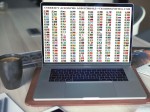Table Of Contents:
- Why Gold Trading is Attractive for Beginners?
Understanding Gold Trading:
Benefits of Gold Trading for Beginners:
Setting Your Gold Trading Goals:
Getting Started: Gold Trading Essentials.
Choosing the Right Gold Trading Platform:
Understanding Gold Market Fundamentals:
Analyzing Gold Price Trends:
Effective Risk Management Strategies:
Top Gold Trading Tips for Beginners:
Developing a Gold Trading Plan:
Practical Steps to Start Gold Trading:
Common Mistakes to Avoid When Trading Gold:
Monitoring and Adjusting Your Gold Portfolio:
Conclusion: Essential Gold Trading Tips for Beginners.
Why Gold Trading is Attractive for Beginners?
Gold, often regarded as the "king of metals", has captivated humanity for millennia. Its intrinsic value, stability, and universal appeal make it an alluring asset for investors, especially for those who are just beginning their journey into the world of trading. In this section, we will delve into the compelling reasons why gold trading holds a distinct allure for beginners and why it should be a consideration as you embark on your investment path.
1. Preservation of Wealth:
Gold has a long history of preserving wealth and maintaining its value over time. Unlike paper currencies, which can be subject to inflation and devaluation, gold has retained its purchasing power for centuries. This intrinsic stability makes it an attractive option for beginners who seek to protect their investments from economic volatility.
2. Diversification of Portfolios:
Successful investing often involves diversifying your assets to spread risk. Gold provides an excellent means of diversification, as its value tends to move independently of traditional financial assets like stocks and bonds. By incorporating gold into your portfolio, you can reduce overall risk and enhance its resilience to market fluctuations.
3. Hedge Against Economic Uncertainty:
Gold is often referred to as a "safe-haven" asset, sought after during times of economic turmoil and uncertainty. When financial markets are volatile, and geopolitical tensions rise, gold tends to shine. Its value can rise when other investments falter, providing a protective hedge for your wealth.
4. Accessibility and Liquidity:
Gold trading is accessible to investors of all backgrounds and budgets. You can start with small investments and gradually expand your portfolio. Additionally, gold is a highly liquid asset, meaning you can easily buy and sell it in the global marketplace, ensuring you can convert your holdings into cash when needed.
5. Long-Term Investment Potential:
For beginners with a long-term investment horizon, gold offers the potential for significant growth over time. Its scarcity and enduring demand, combined with global economic trends, can contribute to substantial gains in the future.
6. Psychological Comfort:
Gold trading often provides a sense of psychological comfort for beginners. Knowing that you have a portion of your portfolio invested in a tangible and historically valuable asset can help alleviate anxiety during turbulent economic periods.
As you embark on your journey into gold trading, keep these compelling reasons in mind. Gold's stability, diversification benefits, and resilience during uncertain times make it an attractive choice for beginners and experienced investors alike. In the following sections of this guide, we will delve deeper into the strategies and techniques that will enable you to harness the full potential of gold trading while minimizing risks.
Understanding Gold Trading:
When diving into the world of gold trading as a beginner, it's crucial to grasp the fundamentals of what gold trading entails and appreciate the historical significance of this precious metal.
What is Gold Trading?
At its core, gold trading refers to the buying and selling of gold in various forms, including: physical gold, gold futures contracts, and exchange-traded funds (ETFs) backed by gold. Gold can be traded on a global scale through financial markets, such as commodity exchanges, or in the form of physical bullion through dealers and institutions.
Gold trading can take place in several ways:
- Physical Gold: This involves the purchase and ownership of physical gold in the form of coins, bars, or jewelry. While physical gold provides tangible ownership, it may require secure storage and insurance.
- Futures and Options: Gold futures contracts are standardized agreements to buy or sell a specific quantity of gold at a predetermined price and date in the future. Options contracts give traders the right, but not the obligation, to buy or sell gold at a specific price within a set timeframe.
- ETFs and Mutual Funds: Gold-backed ETFs and mutual funds pool investors' money to invest in physical gold or gold futures. These funds offer easy diversification and liquidity for traders.
- Gold CFDs (Contracts for Difference): CFDs allow traders to speculate on the price movement of gold without owning the physical asset. They are leveraged products, which means traders can amplify potential gains but also incur higher risks.
Historical Significance of Gold:
Understanding the historical significance of gold provides context for its enduring value and appeal in the modern financial world. Throughout history, gold has held various roles:
- Currency: Gold has been used as a form of currency and a store of value for centuries. Ancient civilizations, such as the Egyptians and Romans, minted gold coins for trade and commerce.
- Wealth Preservation: Gold has consistently preserved wealth over time. During economic crises, wars, and hyperinflation periods, gold remained a reliable asset that retained its value when other investments faltered.
- International Trade: The gold standard, which prevailed in the 19th and early 20th centuries, linked the value of a country's currency to a specific quantity of gold. This system facilitated international trade and stability.
- Jewelry and Ornamentation: Beyond its financial role, gold has been prized for its beauty and used in the creation of jewelry, religious artifacts, and ornamental objects throughout history.
By understanding the historical role of gold and its evolution into a modern investment asset, beginners can appreciate the enduring appeal and potential of gold trading. As we proceed through this guide, we will explore how to harness the benefits of gold trading while navigating the contemporary financial landscape.
Benefits of Gold Trading for Beginners:
Entering the world of gold trading as a beginner opens the door to a range of compelling benefits that can enhance your investment journey. Let's explore two key advantages: diversification in your investment portfolio and the ability to hedge against economic uncertainty.
Diversification in Your Investment Portfolio:
Diversification is a fundamental principle in investment strategy, and gold trading offers an effective means to achieve it. Here's how gold can contribute to diversifying your portfolio:
- Reducing Risk: Gold often exhibits a low or negative correlation with other assets like stocks and bonds. This means that when traditional financial markets experience downturns, gold may rise in value. Including gold in your portfolio can help mitigate risk and minimize losses during market turbulence.
- Enhancing Portfolio Stability: A well-diversified portfolio is more stable and resilient in the face of economic volatility. Gold's stability can act as a counterbalance to the fluctuations of other assets, helping to maintain overall portfolio stability.
- Preserving Wealth: Gold's historical track record of preserving wealth makes it a valuable asset during uncertain times. When the value of paper currencies diminishes due to inflation or economic crises, gold often retains or increases its value, providing a safeguard for your investments.
Hedge Against Economic Uncertainty:
One of the most compelling reasons to engage in gold trading, especially for beginners, is its role as a hedge against economic uncertainty:
- Safe-Haven Asset: Gold has earned its reputation as a "safe-haven" asset. During times of economic turmoil, geopolitical instability, or financial crises, investors tend to flock to gold as a store of value. The increased demand for gold can drive up its price, potentially offering significant gains to traders.
- Protection from Inflation: Inflation erodes the purchasing power of fiat currencies, but gold has historically retained its value and even appreciated during inflationary periods. Holding gold can help protect your wealth from the erosive effects of rising prices.
- Global Economic Trends: Gold often responds positively to global economic trends. Factors like currency devaluation, political instability, and trade tensions can influence the price of gold, providing trading opportunities for those who monitor these events.
As a beginner in gold trading, recognizing the benefits of diversification and the protective role of gold against economic uncertainty is key to making informed investment decisions. In the following sections of this guide, we will further explore strategies and tips to leverage these advantages effectively in your gold trading journey.
Setting Your Gold Trading Goals:
Before you start your gold trading journey as a beginner, it's essential to establish clear and achievable goals. Setting specific goals not only provides you with a sense of direction but also helps you tailor your trading strategies to meet your objectives. In this section, we'll explore how to set your gold trading goals effectively, including differentiating between short-term and long-term objectives and conducting a risk tolerance assessment.
Short-term vs. Long-term Objectives:
Short-term Objectives:
- Capital Growth: If your primary goal is to generate quick profits or grow your capital in the short term, you may focus on short-term trading strategies. These involve taking advantage of short-term price movements in the gold market. Keep in mind that short-term trading often carries higher risks and requires more active monitoring.
- Learning and Experience: Some beginners may prioritize learning and gaining experience in gold trading over immediate financial gains. In this case, your goal might be to build your knowledge, hone your trading skills, and understand the dynamics of the gold market.
Long-term Objectives:
- Wealth Preservation: Long-term investors often view gold as a means to preserve and protect their wealth over time. If your goal is wealth preservation, you may hold onto your gold investments for extended periods, leveraging gold's historical stability.
- Retirement Planning: Gold can also play a role in long-term retirement planning. Setting aside a portion of your investments in gold can provide a hedge against inflation and economic uncertainty, ensuring your retirement nest egg retains its value.
Risk Tolerance Assessment:
Conducting a risk tolerance assessment is a crucial step in setting your gold trading goals. It involves evaluating your willingness and capacity to take on risk in your trading activities. Here's how to assess your risk tolerance:
- Personal Risk Appetite: Consider your individual comfort level with risk. Are you willing to accept the potential for larger losses in pursuit of higher returns, or do you prefer a more conservative approach with lower risk?
- Financial Situation: Assess your financial stability and the impact of potential losses on your overall financial situation. Ensure that your trading activities align with your financial goals and resources.
- Time Horizon: Determine your investment time horizon. Are you looking to achieve your goals in the short term, or do you have a longer time horizon for your investments? Your time frame can influence your risk tolerance.
- Diversification: Evaluate your portfolio diversification. A well-diversified portfolio can help spread risk and reduce the impact of losses in any single asset, including gold.
By understanding the distinction between short-term and long-term goals and conducting a thorough risk tolerance assessment, beginners can tailor their gold trading strategies to align with their objectives and comfort level with risk. In the subsequent sections of this guide, we'll explore the practical steps and strategies to turn your goals into a successful gold trading journey.
Getting Started: Gold Trading Essentials.
As a beginner in the world of gold trading, it's essential to familiarize yourself with the key essentials before diving into the market. In this section, we'll explore the fundamental aspects of gold trading, including the various types of gold investments and the distinction between physical and digital forms of gold.
Types of Gold Investments:
Physical Gold:
- Gold Coins: Physical gold coins, often issued by governments and mints, are a popular choice for investors and collectors alike. These coins typically contain a specified amount of pure gold and are valued based on their weight and purity.
- Gold Bars: Gold bars are larger and typically come in higher denominations than coins. They are favored by investors who seek to store larger quantities of gold in a more compact form.
- Jewelry: While primarily appreciated for its aesthetic appeal, gold jewelry also represents a form of physical gold investment. Keep in mind that the value of gold jewelry is not solely determined by its gold content but also by craftsmanship and design.
Gold Futures and Options:
- Futures Contracts: Gold futures contracts are agreements to buy or sell a specific quantity of gold at a predetermined price and date in the future. Futures allow for speculation on the future price of gold without owning the physical metal.
- Options Contracts: Gold options give traders the right, but not the obligation, to buy or sell gold at a specific price within a set timeframe. Options offer flexibility and can be used for various trading strategies.
Gold Exchange-Traded Funds (ETFs):
- Physical Gold ETFs: These ETFs hold physical gold bullion as their underlying asset. Investors can buy shares in the ETF, representing a fractional ownership of the gold held in the fund.
- Gold Mining ETFs: Some ETFs track the performance of gold mining companies. Investing in these ETFs provides exposure to the gold industry rather than direct ownership of physical gold.
Different Forms of Gold: Physical vs. Digital.
Physical Gold:
- Advantages: Owning physical gold provides tangible ownership and a sense of security. It can be held privately or stored in secure vaults. Physical gold also has aesthetic value, especially in the form of jewelry.
- Considerations: Storing physical gold may involve additional costs for safekeeping and insurance. When selling, you'll need to find a reputable buyer, which can be less convenient than digital trading.
Digital Gold:
- Advantages: Digital gold, often traded through online platforms, offers convenience and liquidity. You can buy and sell digital gold quickly, and it's often more accessible to beginners.
- Considerations: Digital gold doesn't provide physical ownership. It relies on digital records and may involve counterparty risk if you're not holding the gold through a reputable platform.
Understanding the various types of gold investments and the distinction between physical and digital forms is a crucial step in getting started with gold trading. Your choice will depend on factors such as your investment goals, risk tolerance, and preferred level of involvement in the physical ownership of gold. In the subsequent sections of this guide, we will explore strategies and techniques for trading gold effectively, regardless of your chosen form of investment.
Choosing the Right Gold Trading Platform:
Navigating the world of gold trading as a beginner can be both exciting and daunting. To embark on this journey with confidence, you need a dependable partner: a gold trading platform that suits your specific needs and aspirations. In this section, we will explore the essential considerations for selecting the ideal gold trading platform that will serve as your gateway to the dynamic world of precious metals. Recognizing the significance of this decision and understanding how to make a wise choice will pave the way for a successful and enriching gold trading experience.
Factors to Consider in Platform Selection:
Regulation and Security:
Ensure the platform is regulated by reputable financial authorities. Regulatory oversight provides a level of investor protection and helps ensure the platform operates transparently and ethically.
Accessibility and User-Friendliness:
Choose a platform that is user-friendly and offers a straightforward interface. As a beginner, you'll want a platform that doesn't overwhelm you with complex features.
Range of Gold Products:
Consider the variety of gold products available on the platform. Does it offer physical gold, gold ETFs, futures contracts, or options? Having a diverse range of gold assets allows you to tailor your investment approach.
Fees and Costs:
Evaluate the fee structure of the platform. Look for transparent pricing that includes commissions, spreads, and any other charges. Lower trading costs can significantly impact your overall returns.
Trading Tools and Resources:
Investigate the trading tools and resources offered by the platform. Analytical tools, market research, and educational materials can assist you in making informed trading decisions.
Customer Support:
Quality customer support is crucial, especially for beginners who may have questions or encounter issues. Check the availability of customer support channels and their responsiveness.
Demo Accounts:
Some platforms offer demo accounts, allowing you to practice trading with virtual funds. This is an excellent way for beginners to gain hands-on experience without risking real money.
Recognizing and Avoiding Unsuitable Gold Trading Platforms:
Choosing the right gold trading platform is crucial for your success as a beginner. Equally important is knowing how to identify and steer clear of unsuitable or untrustworthy platforms. Here are some essential tips to help you recognize and avoid a bad gold trading platform:
Lack of Regulation:
One of the most significant red flags is the absence of regulation by reputable financial authorities. Avoid platforms that operate without proper oversight, as this can expose you to unnecessary risks.
Opaque Fee Structure:
Be cautious if a platform's fee structure is unclear or convoluted. Hidden fees or excessive charges can erode your profits over time. A reputable platform should provide transparent pricing.
Limited Security Measures:
Prioritize platforms that prioritize security. Check for features like two-factor authentication (2FA), encryption, and secure storage of personal and financial information.
Poor Customer Reviews:
Research customer reviews and feedback on independent websites and forums. If a platform has a history of customer complaints, it's a warning sign of potential issues.
Lack of Educational Resources:
A good trading platform often provides educational resources to assist traders, especially beginners. If a platform offers no educational materials or support, it may not be suitable for learning and growing as a trader.
Unresponsive Customer Support:
Test the platform's customer support by reaching out with inquiries or concerns. Slow or unhelpful customer support can be frustrating and detrimental to your trading experience.
No Demo Account Option:
A lack of a demo account option could be indicative of a platform that doesn't prioritize trader education and skill development. A demo account is essential for practicing and gaining experience without risking real capital.
High-Pressure Sales Tactics:
Be cautious of platforms that employ high-pressure sales tactics to push you into making quick decisions. Reputable platforms should allow you the time and space to make informed choices.
Inadequate Asset Selection:
If a platform offers an extremely limited range of gold trading options, it may not meet your diversified trading needs. Look for platforms with a comprehensive selection of gold assets.
By staying vigilant and following these guidelines, you can protect yourself from unscrupulous platforms and make informed decisions when choosing a gold trading platform that aligns with your goals and values. Remember that a trustworthy platform is the foundation of a successful trading journey.
Understanding Gold Market Fundamentals:
Before diving into gold trading, it's essential for beginners to grasp the fundamental dynamics that drive the gold market. This understanding will empower you to make informed trading decisions. In this section, we'll explore the core concepts of gold market fundamentals, including supply and demand dynamics and the key factors that influence gold prices.
Supply and Demand Dynamics:
Gold Supply:
The supply of gold primarily comes from two sources: mining and recycling:
- Mining involves extracting gold from the earth, and the volume of newly mined gold each year contributes to the overall supply.
- Recycling, on the other hand, includes melting down and reusing existing gold, often sourced from jewelry and industrial applications.
Gold Demand:
Gold has diverse demand sources:
- Jewelry: The largest demand sector for gold is the jewelry industry, driven by cultural and aesthetic preferences.
- Investment: Investors purchase gold for various reasons, including portfolio diversification and wealth preservation.
- Industrial Use: Gold has industrial applications, particularly in electronics, due to its excellent conductivity.
- Central Banks: Some central banks hold gold reserves as a form of monetary stability and security.
Balance of Supply and Demand:
The gold market's equilibrium is influenced by the balance between supply and demand. When demand outpaces supply, gold prices tend to rise, and vice versa. Economic and geopolitical factors can trigger fluctuations in supply and demand dynamics.
Factors Influencing Gold Prices:
Interest Rates and Monetary Policy:
Gold and interest rates often exhibit an inverse relationship. When interest rates are low, the opportunity cost of holding gold (which doesn't generate interest or dividends) is reduced, making gold more attractive. Central bank policies, such as quantitative easing, can also impact gold prices.
Inflation and Currency Value:
Gold is often seen as a hedge against inflation. When inflation rises, the real value of fiat currencies diminishes, and investors turn to gold to preserve their purchasing power.
Geopolitical Events:
Political instability, conflicts, and geopolitical tensions can lead to a flight to safety, boosting demand for gold as a safe-haven asset.
Global Economic Trends:
Economic indicators, such as GDP growth, employment rates, and trade balances, can influence gold prices. Economic uncertainty can drive investors toward gold.
Currency Movements:
Since gold is priced in U.S. dollars, fluctuations in currency exchange rates can impact gold prices for investors in other currencies.
Speculation and Sentiment:
Market sentiment and speculative trading can lead to short-term price volatility. Traders often react to news and events, causing rapid price swings.
Gold Production and Exploration:
Changes in gold production, exploration discoveries, and mining operations can affect the supply side of the gold market.
By understanding the interplay of supply and demand dynamics and recognizing the key factors that influence gold prices, beginners can navigate the gold market with greater insight and confidence. In the subsequent sections of this guide, we will delve into strategies for analyzing gold price trends and making informed trading decisions based on these fundamentals.
Analyzing Gold Price Trends:
To become a proficient gold trader, beginners must develop the skills to analyze gold price trends effectively. Analyzing these trends requires a combination of technical and fundamental analysis. In this section, we'll explore both methods to help you make informed decisions in your gold trading journey.
Technical Analysis for Gold Trading:
Price Charts:
Technical analysts study price charts to identify patterns and trends. Common chart types include line charts, bar charts, and candlestick charts. By analyzing historical price data, traders can identify potential price direction.
Support and Resistance Levels:
- Support levels represent price points where an asset historically finds buying interest, preventing it from falling lower.
- Resistance levels are where selling interest tends to emerge, preventing the price from rising further.
Recognizing these levels can aid in decision-making.
Indicators and Oscillators:
Technical analysts use various indicators and oscillators like Moving Averages, Relative Strength Index (RSI), and MACD to gain insights into price momentum and potential reversals.
Chart Patterns:
Patterns like head and shoulders, triangles, and flags can provide clues about future price movements. Traders often look for these patterns to anticipate market behavior.
Volume Analysis:
Trading volume can confirm or invalidate price movements. Sudden spikes in volume often accompany significant price changes, indicating strong buying or selling pressure.
Fundamental Analysis for Gold Investors:
Economic Indicators:
Fundamental analysis for gold trading involves monitoring economic indicators such as GDP growth, employment data, and inflation rates. A robust economy may reduce gold's appeal as a safe-haven asset, while economic uncertainty can drive up demand.
Central Bank Policies:
Keep an eye on central bank policies, interest rates, and monetary easing measures. Changes in monetary policy can impact the value of fiat currencies and influence gold prices.
Geopolitical Events:
Political instability and global events can have a profound effect on gold prices. Tensions, conflicts, and uncertainties often lead to increased gold demand.
Dollar Strength:
Since gold is priced in U.S. dollars, changes in the dollar's strength can affect gold prices. A weaker dollar typically results in higher gold prices.
Gold Production and Supply:
Monitoring gold production, mining trends, and supply can provide insights into future price movements. A decrease in production or supply disruptions can drive prices higher.
Investor Sentiment:
Sentiment indicators and surveys can gauge investor sentiment towards gol:
- Positive sentiment may indicate bullish conditions,
- while negative sentiment could suggest a bearish outlook.
Successful gold trading often combines technical and fundamental analysis. Technical analysis helps with short-term price predictions and entry/exit points, while fundamental analysis provides a broader understanding of the market's underlying forces. Beginners should develop a well-rounded analytical approach to make informed gold trading decisions.
Effective Risk Management Strategies:
Risk management is a critical aspect of gold trading, especially for beginners. Implementing effective risk management strategies is essential to protect your capital and navigate the inherent volatility of the market. In this section, we'll explore two key risk management techniques: the use of stop-loss orders and position sizing, as well as the importance of diversifying your gold portfolio.
Stop-Loss Orders and Position Sizing:
Stop-Loss Orders:
A stop-loss order is a predefined order that automatically sells your position when the market reaches a specified price level. It acts as a safety net to limit potential losses.
This prevents you from incurring larger losses in case of adverse price movements.
Position Sizing:
Position sizing involves determining the size of your trading positions based on your risk tolerance and overall portfolio size. It's crucial to avoid allocating too much capital to a single trade. A common rule of thumb is not to risk more than 1-2% of your total trading capital on a single trade. This ensures that no single loss can significantly impact your overall portfolio.
Diversifying Your Gold Portfolio:
Asset Diversification:
Diversification involves spreading your investments across different asset classes to reduce risk. While gold itself is a diversification asset, you can further diversify within the precious metals category by considering other metals like silver, platinum, or palladium. Each metal has unique price drivers and can respond differently to market conditions.
Investment Vehicles:
Consider diversifying your gold investments by using various vehicles, such as physical gold, gold ETFs, and gold mining stocks. Each of these assets may have different risk-return profiles and can help balance your portfolio.
Geographic Diversification:
Geographic diversification involves holding gold assets from different regions or countries. Political, economic, or currency-specific events can impact gold prices differently in various parts of the world. By diversifying geographically, you reduce exposure to regional risks.
Time Horizon Diversification:
Diversify your gold investments across different time horizons. Some positions may be geared towards short-term trading, while others are aimed at long-term wealth preservation. Having a mix of short and long-term investments can help balance risk and potential returns.
Effective risk management is the cornerstone of successful gold trading. By incorporating stop-loss orders, prudent position sizing, and a diversified gold portfolio into your trading strategy, you can minimize potential losses and increase your chances of achieving your trading goals as a beginner.
Top Gold Trading Tips for Beginners:
As a novice gold trader, you're embarking on a journey filled with opportunities and challenges. To help you navigate the exciting world of gold trading successfully, here are some top tips tailored specifically for beginners.
Timing Your Gold Trades:
Stay Informed About Economic Events:
Economic indicators, central bank policies, and geopolitical events can significantly impact gold prices. Keep an eye on economic calendars and news to be aware of potential market-moving events. "For example, announcements related to interest rates, inflation, and political developments can lead to price fluctuations".
Understand Market Hours:
The gold market operates 24 hours a day, five days a week, across different global exchanges. Familiarize yourself with market hours and trading sessions to identify optimal times for your trading activities. Volatility and liquidity can vary throughout the day.
Utilize Technical Analysis:
Technical analysis involves studying price charts and patterns to identify potential entry and exit points. Learn to recognize common chart patterns, such as head and shoulders, triangles, and trendlines. Technical analysis can help you make more informed trading decisions.
Recognizing Trading Patterns:
Master Candlestick Patterns:
Candlestick patterns provide valuable insights into market sentiment and potential price reversals. Key patterns to learn include doji, hammer, and engulfing patterns. These can signal changes in market direction.
Study Chart Patterns:
Chart patterns, such as double tops and bottoms, flags, and pennants, can help you anticipate price movements. These patterns often repeat and can provide valuable trading opportunities when identified correctly.
Use Moving Averages:
Moving averages smooth out price data and help identify trends. The simple moving average (SMA) and exponential moving average (EMA) are commonly used. Crossovers of shorter-term and longer-term moving averages can signal trend changes.
Apply Support and Resistance Levels:
Support and resistance levels are price levels where buying or selling interest historically emerges. By identifying these levels on your charts, you can anticipate potential price reversals or breakout points.
Combine Indicators:
Consider using technical indicators like the Relative Strength Index (RSI), Moving Average Convergence Divergence (MACD), and Stochastic Oscillator to complement your chart analysis. These indicators can provide additional confirmation for your trading decisions.
Practice with a Demo Account:
Before risking real capital, practice your trading strategies on a demo account. This allows you to gain experience and confidence without incurring losses.
Remember that successful gold trading for beginners requires continuous learning and practice. While these tips can serve as valuable starting points, always conduct thorough research and build your trading skills over time. Trading discipline, risk management, and a commitment to ongoing education are keys to your long-term success as a gold trader.
Developing a Gold Trading Plan:
Establishing a structured trading plan is essential for success in the gold market, particularly for beginners. A well-defined plan helps you navigate the complexities of gold trading with clarity and discipline. In this section, we will discuss the key components of a gold trading plan, including setting entry and exit points and building a trading strategy.
Setting Entry and Exit Points:
Entry Points:
Identify specific conditions or criteria that will trigger your entry into a gold trade. This could include technical signals, fundamental factors, or a combination of both.
Exit Points:
Equally important is determining when to exit a trade. Establish clear exit criteria, including stop-loss and take-profit levels.
- A stop-loss order should be set at a price point where you're willing to accept a manageable loss if the trade goes against you.
- Take-profit levels represent where you plan to secure your profits.
Risk-Reward Ratio:
Calculate and maintain a favorable risk-reward ratio for each trade. A common guideline is to aim for a minimum of a 1:2 risk-reward ratio. "This means that for every dollar you're willing to risk (your stop-loss), you should aim for at least two dollars in potential profit (your take-profit)".
Building a Trading Strategy:
Choose Your Trading Style:
Determine your preferred trading style, whether it's day trading, swing trading, or long-term investing. Your trading style will influence the frequency of your trades and the timeframes you use for analysis.
Technical and Fundamental Analysis:
Decide how you will incorporate technical and fundamental analysis into your trading strategy. "Will you primarily rely on technical indicators, chart patterns, and price action? Or will you also consider fundamental factors like economic events and geopolitical news?"
Position Sizing and Risk Management:
- Implement a position sizing strategy that aligns with your risk tolerance. Determine the percentage of your trading capital you're willing to risk on each trade.
- Adhere to strict risk management principles, such as not risking more than 1-2% of your total trading capital on a single trade.
Trade Management:
Develop rules for managing open positions, including trailing stop-loss orders and partial profit-taking strategies. Knowing how to adjust your stops and when to scale out of winning positions can maximize your returns.
Continuous Learning:
Commit to ongoing education and improvement. The markets evolve, and staying informed about new strategies and tools is crucial for long-term success.
Emotional Discipline:
Maintain emotional discipline in your trading. Stick to your plan and avoid making impulsive decisions based on fear or greed. Emotional control is a hallmark of successful traders.
Remember that a trading plan is a dynamic document that may evolve over time as you gain experience and adapt to changing market conditions. Developing and following a well-structured plan is a fundamental step toward becoming a successful gold trader, ensuring that you approach each trade with clarity and confidence.
Practical Steps to Start Gold Trading:
Embarking on your gold trading journey requires practical steps to set up your trading account and execute your first trade. In this section, we'll walk you through the process of opening a gold trading account and making your initial gold trade as a beginner.
Opening a Gold Trading Account:
Choose a Reputable Broker:
Begin by selecting a reputable broker or trading platform that offers gold trading services. Ensure that the broker is regulated by recognized financial authorities to safeguard your investments.
Complete the Registration:
Sign up on the selected broker's website by providing your personal information and contact details. You may also need to verify your identity as part of the registration process.
Fund Your Account:
After registration, fund your trading account with the initial capital you intend to trade with. Brokers typically offer various deposit methods, including bank transfers, credit/debit cards, and electronic payment systems.
Choose a Trading Platform:
Most brokers provide trading platforms for you to use. Familiarize yourself with the platform's features, as it will be your primary tool for executing trades and analyzing the market.
Practice with a Demo Account:
Before trading with real money, consider using the broker's demo account option. A demo account allows you to practice trading with virtual funds, gaining valuable experience without risking your capital.
Making Your First Gold Trade:
Research and Analysis:
Start by conducting research and analysis to identify a trading opportunity. You can use both technical and fundamental analysis, as discussed in earlier sections of this guide, to inform your decision.
Set Entry and Exit Points:
Based on your analysis, determine your entry and exit points. Specify the price at which you will enter the trade and set stop-loss and take-profit levels to manage risk.
Place Your Trade:
Access your trading platform and locate the gold trading asset. Choose the desired trade size and execute the trade according to your predetermined plan.
Monitor Your Trade:
After placing your trade, monitor it closely. Watch for price movements and be prepared to adjust your stop-loss or take-profit orders if necessary.
Embrace Learning and Adaptation:
Be prepared for both successful and unsuccessful trades as a beginner. Each trade offers a learning opportunity. Keep a trading journal to record your trades and analyze your performance for continuous improvement.
Risk Management:
Throughout your trading journey, stick to the risk management principles discussed earlier. Avoid overleveraging your trades and only risk a portion of your trading capital on each trade.
Starting gold trading as a beginner may seem daunting, but by following these practical steps, you'll be well on your way to becoming a knowledgeable and confident gold trader. Remember that patience, discipline, and continuous learning are key to long-term success in the gold market.
Common Mistakes to Avoid When Trading Gold:
While gold trading offers significant potential for profit, it also comes with pitfalls that beginners should be aware of. Avoiding common mistakes is crucial for successful trading. In this section, we'll highlight two prevalent mistakes that many novice gold traders make and provide guidance on how to steer clear of them.
Overtrading and Emotional Decision-Making:
Overtrading:
Overtrading is a common pitfall for beginners who may become overly excited or anxious about every market movement. It involves trading too frequently or with excessively large positions, often driven by the desire to make quick profits.
Avoidance Tip: Establish a clear trading plan with specific entry and exit points. Stick to your plan and avoid deviating from it due to impulsive urges. Limit the number of trades you make in a given timeframe and only invest capital you can afford to lose.
Emotional Decision-Making:
Emotional decision-making can lead to costly mistakes. Fear and greed are two powerful emotions that can cloud judgment and prompt rash actions. Panic selling during market downturns or holding onto losing positions out of hope are examples of emotional decisions.
Avoidance Tip: Cultivate emotional discipline by adhering to your trading plan. Implement stop-loss orders to limit potential losses and prevent emotional attachment to losing trades. Remember that trading decisions should be based on analysis and strategy, not emotions.
Neglecting Research and Analysis:
Insufficient Research:
Neglecting to conduct thorough research and analysis is a common mistake. Some beginners may rely on hunches or tips from others without understanding the factors driving gold prices.
Avoidance Tip: Dedicate time to research and analysis before making any trade. Consider both technical and fundamental factors, as discussed in earlier sections. A well-informed trader is better equipped to make rational decisions.
Failure to Adapt:
Market conditions change over time, and failing to adapt to evolving circumstances can lead to losses. A strategy that worked in one market environment may not be effective in another.
Avoidance Tip: Continuously update your knowledge and adapt your strategies as needed. Stay informed about economic events, geopolitical developments, and changes in market sentiment. Be flexible and open to adjusting your approach based on current conditions.
Lack of Risk Management:
Neglecting risk management practices can result in significant losses. Some beginners may trade without setting stop-loss orders or allocating an appropriate portion of their capital to each trade.
Avoidance Tip: Prioritize risk management by setting stop-loss and take-profit levels for every trade. Ensure your position sizes align with your risk tolerance and overall portfolio. Follow the risk management principles discussed earlier in this guide.
By avoiding these common mistakes and adhering to prudent trading practices, beginners can improve their chances of success in the gold market. Remember that trading is a skill that develops over time, and learning from mistakes is an essential part of the journey toward becoming a proficient gold trader.
Monitoring and Adjusting Your Gold Portfolio:
Successfully trading and investing in gold doesn't end with your initial trades. To achieve long-term success and adapt to changing market conditions, you must actively monitor and adjust your gold portfolio. In this section, we'll explore two crucial aspects of managing your gold investments: tracking your gold investments and rebalancing your portfolio.
Tracking Your Gold Investments:
Regularly Review Your Portfolio:
Begin by regularly reviewing the performance of your gold investments. Monitor price movements, changes in asset values, and the overall composition of your portfolio.
Use Portfolio Tracking Tools:
Leverage portfolio tracking tools and software available through your broker or third-party platforms. These tools provide real-time updates on your holdings, allowing you to assess your portfolio's performance at a glance.
Set Performance Benchmarks:
Establish performance benchmarks or goals for your gold investments. These benchmarks can help you gauge whether your portfolio is meeting your objectives. "For example, you might compare your returns to the performance of relevant gold indices or industry benchmarks".
Stay Informed:
Stay informed about macroeconomic trends, geopolitical events, and factors that can impact the gold market. Continuously educate yourself and adjust your portfolio strategy based on your evolving knowledge.
Rebalancing Your Portfolio:
Reevaluate Your Asset Allocation:
Periodically reassess your asset allocation to ensure it aligns with your long-term goals and risk tolerance. Changes in the value of your gold investments or shifts in market conditions may necessitate adjustments.
Consider Diversification:
Rebalancing presents an opportunity to diversify your portfolio further. If one asset class has outperformed others, rebalancing can involve reallocating some of your gains into underperforming or less-correlated assets.
Adapt to Changing Goals:
As your financial goals or circumstances change, your portfolio should adapt accordingly. "For instance, if you initially invested in gold for wealth preservation but now seek growth, you may need to adjust your allocation".
Stay Disciplined:
Maintain discipline during the rebalancing process. Avoid making impulsive decisions based on short-term market movements. Stick to your long-term investment plan and goals.
Tax Considerations:
Be mindful of potential tax implications when rebalancing your portfolio. Consult with a tax advisor or financial professional to minimize tax liabilities while making necessary adjustments.
Rebalancing Frequency:
The frequency of rebalancing can vary based on your individual circumstances. Some investors rebalance annually, while others may do so quarterly or in response to significant market changes. Your chosen rebalancing strategy should align with your goals and risk tolerance.
Monitoring and adjusting your gold portfolio is an ongoing process that requires diligence and adaptability. By staying actively involved in the management of your investments, you can optimize your portfolio's performance and ensure it continues to align with your financial objectives as a gold trader and investor.
Conclusion: Essential Gold Trading Tips for Beginners.
In your journey as a beginner in the world of gold trading, you've been equipped with valuable insights and strategies to embark on this exciting endeavor with confidence and intelligence. Let's summarize the key takeaways from this guide and offer encouragement for a smart start in gold trading.
Summarizing Key Takeaways:
- Understanding Gold Fundamentals: Gold trading begins with a solid foundation in understanding its market fundamentals. Knowledge of supply and demand dynamics and the factors influencing gold prices is crucial.
- Analyzing Gold Trends: The ability to analyze gold price trends using technical and fundamental analysis methods empowers you to make informed trading decisions.
- Effective Risk Management: Implementing risk management strategies, including stop-loss orders and portfolio diversification, is vital for safeguarding your capital.
- Building a Trading Plan: Developing a well-defined trading plan, including entry and exit points, is essential for a structured and disciplined approach to gold trading.
- Practical Steps to Start: You've learned the practical steps to start gold trading, from opening a trading account to making your first trade.
- Avoiding Common Mistakes: By avoiding common mistakes like overtrading and emotional decision-making and prioritizing research and analysis, you can enhance your trading performance.
- Monitoring and Adjusting: Continuously monitoring and adjusting your gold portfolio ensures that it remains aligned with your goals and market conditions.
Encouragement for a Smart Start in Gold Trading:
Embarking on your gold trading journey as a beginner is an exciting and potentially rewarding endeavor. Remember that success in gold trading, like any skill, requires dedication, practice, and ongoing education. Stay disciplined in adhering to your trading plan, manage your risk wisely, and embrace both wins and losses as learning experiences.
Market conditions may change, but your commitment to learning and adapting will serve as your compass. Continue to stay informed about economic events, geopolitical developments, and evolving market dynamics. With patience, diligence, and a resilient mindset, you can navigate the intricate world of gold trading and work towards achieving your financial goals.
As you embark on your smart start in gold trading, remember that knowledge is your most potent tool. Stay curious, remain vigilant, and approach each trade with confidence. Your journey as a gold trader has the potential to be a rewarding and enriching one. Good luck and happy trading!









































